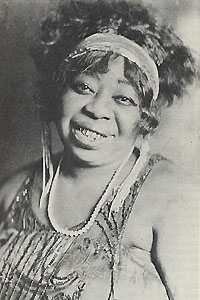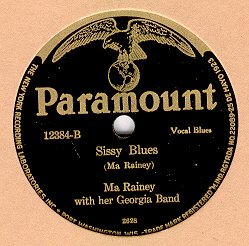Ma Rainey's "Prove It On Me Blues," 1928
Gertrude "Ma" Rainey's Amazing Resistance Anthem
by Jonathan Ned Katz
(This page, by a named author, editor, or curator, can only be edited by that author or OutHistory administrators. But all users are urged to comment on this page and suggest possible changes in its Discuss section.)
Unique in pre-Stonewall American history is an assertive song of lesbian self-affirmation and defiance, "Prove It on Me Blues." Written, performed, and recorded in 1928 by the famous early blues singer Ma Rainey, this extraordinary song of resistance features a woman-loving woman who proclaims her sexual interest in females and challenges the world to "prove it on me."[1]
Sung in the first person by Rainey in the character of a collar-and-tie-wearing, man-disdaining butch, "Prove It on Me Blues" is a rare and wonderful rebel anthem. (See below for lyrics.)
How did the amazing "Prove It on Me Blues" come to be written and recorded? The answer is found in Mother of the Blues by Sandra Lieb (University of Massachusetts Press, 1981), the major study of Gertrude "Ma" Rainey and her work.
"There is strong evidence," writes Lieb, who interviewed a number of Rainey's coworkers, "to indicate that Ma Rainey ... was bisexual."
In 1925, just three years before she recorded "Prove It on Me Blues," Rainey was reportedly arrested
when Chicago police raided a wild party, catching Ma and the chorines from her show in a state of undress. Blues singer Bessie Smith is said to have bailed Rainey out of jail, and the bisexual Smith is the only alleged lover of Rainey's who is specifically named by Lieb.
Advertisement for "Prove It On Me"
To what extent was Rainey, the person, identified with the character who sings "Prove It on Me Blues"? Surprisingly, the illustration and text of the record company's original 1928 ad for "Prove It on Me Blues" (reproduced by Lieb from the black newspaper the Chicago Defender) explicitly links the performer Rainey and the singer-narrator of "Prove It on Me Blues" strongly links Ma Rainey wtth the bull dyke character whose song she sang.[2]
The ad pictures a large woman in a collar and tie, tailored suit jacket, and masculine-looking hat and vest, talking to two slender women in femme drag; a policeman watches. The ad's text, which identifies the large woman in the illustration as Rainey, coyly asks:
What's all this? Scandal? Maybe so, but you wouldn't have thought of it "Ma" Rainey. But look at that cop watching her! What does it all mean? But "Ma" just sings "Prove It on Me."
As a performer, Rainey did sing as a variety of characters. In the greatest number of her 92 recorded songs, she appeared as a sex-loving, misused and abused, depressed and angry, man-loving woman.
But the evidence of lesbianism in Rainey's life and the ad linking the performer Ma Rainey with the singer-narrator of "Prove It on Me Blues" strongly suggest the merging of Ma with the butch whose song she sang.
Historical Context
At the very time when Radclyffe Hall's The Well of Loneliness was being suppressed in the United States as obscene, African-American audiences could apparently appreciate lesbianism in a performer and a song's narrator. "Songs of unconventional sexuality," says Lieb, "were not unusual in the blues and in live black entertainment." Nor were raunchy songs of conventional sex.
Rainey's own composition "Sissy Blues" was a matter-of-fact complaint by a woman whose male lover was stolen by a "sissy" man, "Miss Kate. " Several recordings exist of a song about lesbians, "Bull Dyker's Dream."
Most telling, perhaps, at the bottom of the ad for "Prove It on Me Blues," is a record-company offer of "favorite spirituals." Pious hymns coexisted peacefully in the same Afro-American universe as this bawdy musical boast of lesbianism.
The Economy of the Time
What about the economy of Rainey's time might help to explain the recording and distribution of this provocative song? In 1928, explains Lieb, "increasingly suggestive and sensational material appeared in blues recordings" as record companies tried to reverse the decline in sales that resulted from competition with radio and the new talking pictures.
Between 1923 and 1928, Rainey "leapt from Southern minstrel star to national recording artist." Then, in the late 19208, Lieb tells us, show business "became more centralized" and was "increasingly controlled by larger corporations," which tried to satisfy a "mainstream and Puritanical taste." The "entire entertainment industry" moved "closer to traditional white middle-class values." Rainey "slowly faded into obscurity in the early '30s." On Dec. 22, 1939, at the age of 53, Rainey died of heart disease.
On December 22, 1989, on the 50th anniversary of Rainey's death, I suggested that fans of the blue's singer mark the day by turning up the volume and playing her "Prove It on Me Blues" for all the world to hear.
Lyrics: Ma Rainey: Prove It On Me Blues"
Went out last night, had a great big fight Everything seemed to go on wrong I looked up, to my surprise The gal I was with was gone.
Where she went, I don’t know I mean to follow everywhere she goes; Folks say I’m crooked. I didn’t know where she took it I want the whole world to know.
They say I do it, ain’t nobody caught me Sure got to prove it on me; Went out last night with a crowd of my friends, They must’ve been women, ‘cause I don’t like no men.
It’s true I wear a collar and a tie, Makes the wind blow all the while Don’t you say I do it, ain’t nobody caught me You sure got to prove it on me.
Say I do it, ain’t nobody caught me Sure got to prove it on me.
I went out last night with a crowd of my friends, It must’ve been women, ‘cause I don’t like no men. Wear my clothes just like a fan Talk to the gals just like any old man
Cause they say I do it, ain’t nobody caught me Sure got to prove it on me.
References
- ↑ Adapted from Jonathan Ned Katz's "Singing the 'Bull Dyker's' Blues," The Advocate, July 18, 1989, pp. 48-49. Copyright by Katz.
- ↑ Advertisement: http://books.google.com/books?id=DgucZIjiEYgC&pg=PA127&lpg=PA127&dq=%22Prove+It+On+Me+Blues%22+%22Chicago+Defender%22&source=web&ots=Vx36L2ZY2S&sig=g4NpYP3oG2dftwuzptBlDrjOLrI&hl=en


